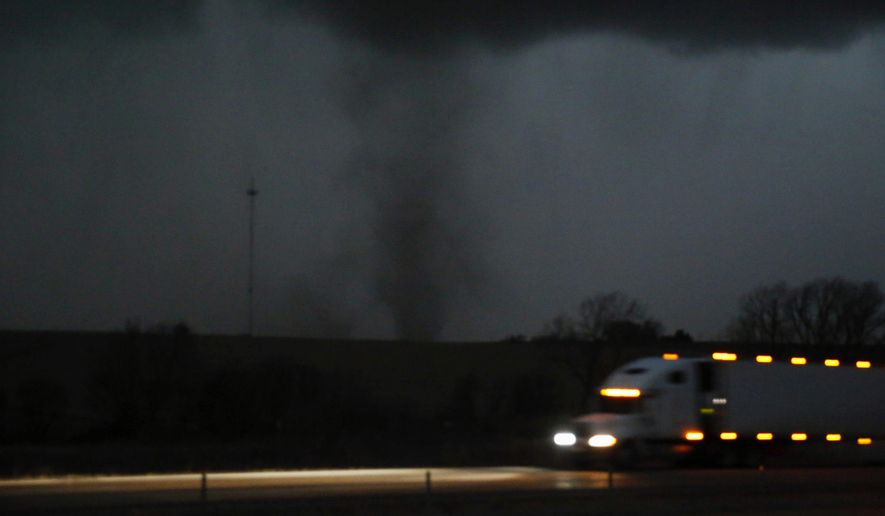OMAHA, Neb. (AP) — One person has died as a powerful storm system swept across the Great Plains and Midwest, authorities said, closing highways and spawning reported tornadoes in Nebraska and Iowa.
A semitrailer was stuck by high winds rolled and onto its side on southbound on U.S. Highway 151 in eastern Iowa on Wednesday evening as severe weather moved through the area, killing the driver, the Iowa State Patrol said.
The storm was shifting north of the Great Lakes on Thursday, with high winds, snow, and hazardous conditions continuing in the upper Great Lakes region, the National Weather Service said. There were at least 13 tornado reports Wednesday in the Plains states, scattered through eastern Nebraska and Iowa. Winds topped 70 mph (113 kph) through much of Kansas, Nebraska and Iowa.
“To have this number of damaging wind storms at one time would be unusual anytime of year,” said Brian Barjenbruch, a meteorologist with the National Weather Service in Valley, Nebraska. “But to have this happen in December is really abnormal.”
The system came on the heels of devastating tornadoes last weekend that cut a path through states including Arkansas, Missouri, Tennessee, Illinois and Kentucky, killing more than 85 people.
The strong winds also whipped up dust that reduced visibility to zero west of Wakeeney, Kansas, the state Department of Transportation said, and caused at least four semitrailers to blow over. Kansas officials closed Interstate 70 from the Colorado border to Salina, as well as all state highways in nine counties in northwest Kansas.
The National Weather Service had issued a high wind warning for an area stretching from New Mexico to upper Michigan, including Wisconsin and Illinois. Gusts topping 80 mph (129 kph) were recorded in the Texas Panhandle and western Kansas. The weather service said an automated observation site in Lamar, Colorado, recorded a gust of 107 mph (172 kph) Wednesday morning. Wind gusts of 100 mph were reported in Russell, Kansas.
Greg Butcher, the city administrator in Seward, Nebraska, said he was standing in his office at city hall Wednesday when he saw a giant wall of cloud rolling toward him. Butcher said he braced for a major hit but so far the worst damage appears to be a few toppled telephone poles.
“We lucked out,” Butcher said. “It came in really fast.”
Officials also warned of a dangerous fire risk along the western edge of the weather system, where conditions were dry.
Scientists say extreme weather events and warmer temperatures, much like what’s happening, are more likely to occur with human-caused climate change. However, scientifically attributing a specific event like this storm system to global warming requires specific analysis and computer simulations that take time, haven’t been done and sometimes show no clear connection.
“I think we also need to stop asking the question of whether or not this event was caused by climate change. All events nowadays are augmented by climate change,” said Northern Illinois University meteorology professor Victor Gensini. “We need to be asking, `To what extent did climate change play a role and how likely was this event to occur in the absence of climate change?’”
The unusually warm temperatures on Wednesday were due in part to record high ocean temperatures in the Gulf of Mexico, which wouldn’t have happened without global warming, said Jeff Masters, a Yale Climate Connections meteorologist who cofounded Weather Underground.
The system blew into the Plains from Colorado, where high winds knocked out power, closed roads and highways and delayed or canceled hundreds of flights. The weather service said a wind gust of 100 mph (160 kph) was recorded on the airfield at the Air Force Academy in Colorado Springs.
___
Stafford reported from Liberty, Missouri.
___
Associated Press writers Ken Miller in Oklahoma City; Terry Wallace in Dallas; Seth Borenstein in Washington D.C.; Jim Anderson in Denver and Grant Schulte in Omaha, Neb., contributed to this report.




Please read our comment policy before commenting.